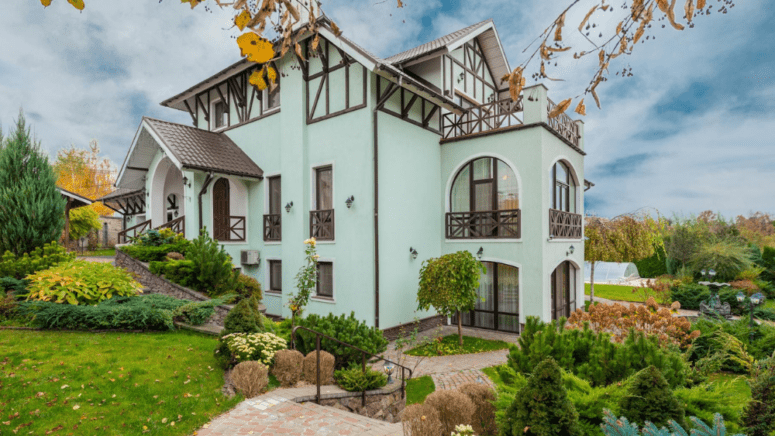10 Tips to Sell Your Tudor Home (+1 Bonus Tip)
- Published on
- 6 min read
-
 Richard Haddad Executive EditorClose
Richard Haddad Executive EditorClose Richard Haddad Executive Editor
Richard Haddad Executive EditorRichard Haddad is the executive editor of HomeLight.com. He works with an experienced content team that oversees the company’s blog featuring in-depth articles about the home buying and selling process, homeownership news, home care and design tips, and related real estate trends. Previously, he served as an editor and content producer for World Company, Gannett, and Western News & Info, where he also served as news director and director of internet operations.
For some, Tudor homes offer a fairy tale look brimming with charm and character. Their distinct architectural style can attract buyers who appreciate history and craftsmanship. If you’re looking to sell a Tudor home, showcasing its unique features can make a big difference in your proceeds and how fast you close the sale.
This guide provides 10 tips for selling your Tudor home, along with insights into common buyer concerns and how to ease their minds.
What is a Tudor home?
A Tudor home is an architectural style inspired by the medieval Tudor period in England, popularized in the United States during the early 20th century. Known for their steeply pitched roofs, decorative half-timbering, and tall, narrow windows, these homes exude a historic charm that continues to captivate buyers.
While their exteriors often feature a mix of brick, stucco, and wood, the interiors are equally distinctive, with details like exposed wooden beams, arched doorways, and intricate craftsmanship. These homes typically evoke a cozy, storybook feel that’s hard to replicate in modern architecture.

Telltale features of a Tudor home
How can you tell if you have a Tudor home? Look for these hallmark features:
- Steeply pitched roofs: A signature element that adds visual drama.
- Decorative half-timbering: Wood framing accents contrasted with stucco or brick infill.
- Leaded glass windows: Often tall, narrow, and grouped in rows.
- Massive chimneys: Sometimes topped with decorative chimney pots.
- Arched doorways: Adding a touch of elegance to entrances and interior spaces.
- Fireplaces and hearths: Often made of stone or brick and positioned as the focal point in the living room.
- Inviting layouts: Asymmetrical interior layout that emphasizes coziness and comfort.
These features make Tudor homes uniquely appealing but also require special care when preparing to sell.
10 tips to help sell your Tudor home
Selling a Tudor home often requires extra preparation, as these unique properties come with their own set of challenges and rewards. The intricate architectural details and historic charm that make Tudor homes so appealing can also raise concerns for some buyers.
For example, in a City Data forum, one user wrote: “I am looking to buy a house in Great Neck [New York]. Some of the Tudor houses seem to offer good value for the size and price. My biggest concern is their age. The ones we saw were built in 1926 or 1931.”
Buyers are often hesitant about purchasing older homes. They worry about everything from repairs and maintenance to resale value. Proactively addressing these concerns can help reassure them and ensure your Tudor home stands out in a competitive market.
From energy efficiency upgrades to highlighting original craftsmanship, each tip in this guide is designed to emphasize your Tudor home’s best features. These steps will not only appeal to the right buyers but also showcase your property’s timeless beauty.

1. Enhance curb appeal
First impressions matter, and a Tudor home’s facade is one of its strongest assets. Maintain or restore exterior elements like the half-timbering, stucco, and brickwork. Adding complementary landscaping — such as lush greenery or flowering shrubs — can further enhance its storybook charm. Consider exterior lighting to highlight architectural features during evening showings.
2. Restore or emphasize original details
Buyers love the authenticity of Tudor homes, so play up their craftsmanship. Highlight unique details like leaded glass windows, wooden beams, and intricate moldings. If any features need repair, consider professional restoration to preserve their historic appeal.
3. Showcase interior charm
Stage your home to highlight its interior features. Draw attention to exposed beams, arched doorways, and fireplaces with tasteful decor that complements the home’s aesthetic. Use neutral but warm tones to create a cozy atmosphere without overwhelming potential buyers.
4. Blend modern updates with vintage charm
While preserving the home’s character, it’s important to meet modern buyer expectations. Update kitchens and bathrooms with features like energy-efficient appliances and classic finishes that harmonize with the Tudor style. For example, choose cabinetry with traditional detailing and avoid overly contemporary designs.
5. Focus on energy efficiency
Tudor homes can be less energy-efficient due to older windows and insulation. Consider upgrading to energy-efficient options that maintain the home’s aesthetic, such as custom storm windows or insulation upgrades. Highlight these improvements in your listing to appeal to eco-conscious buyers.
6. Target the right buyers
Not every buyer will appreciate a Tudor home, so it’s important to market to those who value historic architecture. Work with your agent to craft a listing that emphasizes the home’s unique appeal, cozy atmosphere, and craftsmanship. Highlight any historical significance or upgrades that enhance the property’s livability.
7. Hire an agent familiar with Tudor homes
Selling a Tudor home sometimes requires specialized knowledge. Choose an agent experienced in marketing historic or character homes. They’ll know how to highlight the property’s best features and connect with buyers who appreciate its unique charm.
8. Use a professional stager
A professional stager can help you create a cohesive look that highlights the Tudor home’s charm. They’ll use furniture, decor, and lighting to draw attention to the home’s unique features while ensuring it appeals to modern buyers. A well-staged home often sells faster and for a better price.
9. Highlight the neighborhood
Tudor homes are often found in established neighborhoods with rich histories and mature landscaping. Emphasize the benefits of the surrounding area, such as walkability, schools, or community amenities. Buyers interested in historic homes often value a sense of place and connection.
10. Consider a pre-listing home inspection
Conducting a pre-listing inspection can identify any potential issues before you put your home on the market. Addressing these problems proactively demonstrates to buyers that the home has been well-maintained and can reduce the likelihood of surprises during negotiations.
Bonus tip: Offer a home warranty
Providing a home warranty can give potential buyers added peace of mind, especially when purchasing an older property like a Tudor home. A warranty can cover repairs for systems and appliances, which might ease concerns about maintenance costs. Highlight this perk in your listing to make your home more appealing and help close the deal faster. The average cost of a home warranty is around $1,050 for 12 months but can be up to $2,000, depending on the level of coverage.
FAQs about selling a Tudor home
Do Tudor homes have a higher resale value? Tudor homes can have a higher resale value than more typical homes as long as they are well-maintained and properly prepared for listing. This is particularly true in markets where buyers seek unique, character-filled homes. Their craftsmanship and timeless appeal can make them highly desirable.
What challenges might sellers face? Due to their intricate details and older construction, Tudor homes can have higher maintenance and restoration costs. Additionally, their unique style may not appeal to every buyer. To increase your chances of standing out online (where nearly all home shoppers look first), have your home staged before photos are taken.
How do I price a Tudor home competitively? Pricing can depend on the home’s condition, location, and unique features. Consulting with an agent experienced in historic properties can help determine the right price. One tool that agents have to estimate a listing price is a comparative market analysis (CMA), a comprehensive report that compares your home to nearby similar properties. If your home is unique in the area, you might consider a pre-listing appraisal.
Are there any tax benefits to owning or selling a historic Tudor home? If your Tudor home is part of a historic district or listed on a historic registry, there may be tax incentives for certain types of renovations. Check local regulations or consult a professional for specifics.
What DIY staging tips work best for Tudor homes? Focus on decor that complements the home’s warm and cozy aesthetic, using period-appropriate or understated modern furnishings to enhance its charm.

Ready to sell your Tudor home?
Selling a Tudor home is an opportunity to showcase its timeless charm and craftsmanship to the right buyer. By enhancing its curb appeal, restoring original details, and marketing to buyers who value its historic appeal, you can make your home stand out in the market. Partnering with a knowledgeable agent can further help you secure a great offer while preserving the legacy of this architectural treasure.
Looking for an expert agent? HomeLight can connect you with the top-rated real estate agents in your market. If you’re buying and selling at the same time, check out HomeLight’s modern Buy Before You Sell program, which streamlines the process so you only move once. See this short video to learn how it works.
Header Image Source: (Robert So / Pexels)
- "What Is A Tudor Style House?," Southern Living, Maggie Burch (January 2025)
- "Classic Tudor Exterior Inspiration| Exterior Inspiration Series," The Curb Appeal Co. (April 2023)
- "Easy ways to make an older home more energy efficient," Duke Energy, Laurinda Schenck (July 2023)
- "How Much Does a Home Warranty Cost? [2025 Data]," Angi, Dan Simms (November 2024)
- "100% of buyers now shop for homes online, new report says," Axios, Sami Sparber (November 2023)
